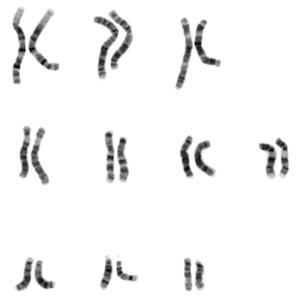Humans and other animals possess two copies of most genes. This stems from the fact that animals contain pairs of chromosomes, one from the mother and one from the father. Humans have 23 pairs of chromosomes -- 23 from mom and 23 from dad -- for a total of 46 chromosomes.
Even though we contain two copies of nearly every gene, that does not mean that our bodies actually use both copies. A handful of genes, about 1% in mammals, are either turned "on" or "off" based on whether they came from the mother or the father. For example, if the mother's version of Gene X is activated, the father's version of Gene X is deactivated. This is known as genomic imprinting.
This biological phenomenon can be problematic. Continuing the above example, suppose a mammal inherits a defective copy of Gene X from the mother. It could be in serious trouble. The animal inherited a deactivated version of Gene X from the father. Because the animal can't activate that gene, it was relying on a healthy, operational version of maternal Gene X. If that doesn't happen, the animal essentially has no functioning Gene X. Depending on what Gene X actually is, this could have devastating consequences.
 A genetic disorder called Prader-Willi syndrome (PWS) in humans is caused by defects involving chromosome 15. Some of the genes on the maternally inherited chromosome are turned off, so their counterparts on the father's chromosome need to be fully functional. (See diagram.) If they are not, a person develops PWS, which manifests as obesity, intellectual disability, and possibly mental illness. PWS patients with mental illness usually experience schizophrenia-like symptoms, such as hallucinations and paranoia.
A genetic disorder called Prader-Willi syndrome (PWS) in humans is caused by defects involving chromosome 15. Some of the genes on the maternally inherited chromosome are turned off, so their counterparts on the father's chromosome need to be fully functional. (See diagram.) If they are not, a person develops PWS, which manifests as obesity, intellectual disability, and possibly mental illness. PWS patients with mental illness usually experience schizophrenia-like symptoms, such as hallucinations and paranoia.
Because they suspected that genes related to paranoia could be located in the Prader-Willi region of chromosome 15, a team of Canadian scientists investigated further. The researchers asked 831 undergraduate students to complete questionnaires aimed at assessing traits associated with schizophrenia and autism. Then, the team sequenced the students' DNA at one specific site on chromosome 15 called rs850807. (See diagram.)
rs850807 is a genetic biomarker known as a single nucleotide polymorphism (SNP). It can be thought of as similar to a mile marker on the interstate. If there is a crash on the highway, emergency responders will want to know which mile marker is closest. Similarly, if there is a genetic disease, scientists want to know which SNP ("mile marker") is nearby. That will help them home in on the true cause of the disease.
The team found that students who exhibited signs of paranoid thinking (specifically, ideas of reference, which is the tendency to interpret random coincidences as highly meaningful or to believe that other people are talking about or plotting against them) had a particular genetic profile: At rs850807, they contained a "C" nucleotide on both the father's and mother's chromosomes. Those with a "T" on either or both chromosomes were less likely to exhibit paranoid thinking*.
Limitations and Conclusions
At least two caveats must be kept in mind with studies like this.
First, a SNP is not necessarily the cause of the genetic disease. Instead, as described above, it is best to think of SNPs as highway mile markers. In this case, individuals who possess a "CC" genotype (i.e., a "C" on both chromosomes) are likelier to exhibit paranoid thinking. That means that people who have this genotype also have versions of genes nearby that may be the true cause of the paranoid thinking. Individuals with "CT" or "TT" genotypes probably have versions of genes nearby that don't lead to paranoia.
Second, the volunteers in this study were all healthy. Though some exhibited paranoid thinking, they were not mentally ill. This is because multiple genes are implicated in mental illness. The genes in the neighborhood of the rs850807 SNP biomarker represent just one region out of potentially hundreds or thousands of genetic regions linked to mental illness.
Still, the fact that a tiny genetic region can have such a profound impact on our thinking patterns is quite remarkable. The authors have contributed meaningfully not just to research on PWS but to behavioral genetics, as well.
*Note: Recall that DNA contains A, T, C, and G nucleotides.
Source: Crespi B, Read S, Salminen I, Hurd P. "A genetic locus for paranoia." Biol. Lett. 14: 20170694. Published: 17-Jan-2018. DOI: 10.1098/rsbl.2017.0694




